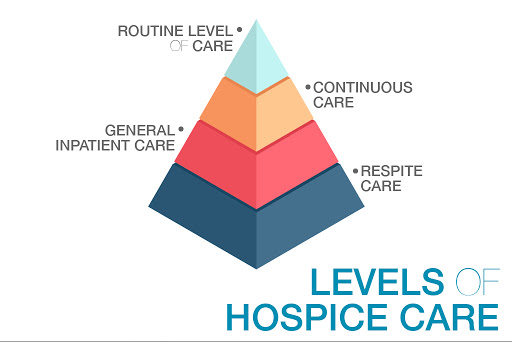
What Are The Four Levels Of Hospice Care?
Hospice care is a compassionate form of end-of-life care encompassing four levels, each offering exceptional support to patients and their loved ones. Let's delve into each class and explore their significance in more detail:
Movement 1: Palliative Care - The Prelude of Comfort
Palliative Care is the first level of the question of what are the four levels of hospice care, and its primary focus is on bringing comfort and relief to patients facing life-limiting illnesses. At this level, a multidisciplinary team of doctors, nurses, counselors, and volunteers addresses physical symptoms such as pain and discomfort. They also provide emotional and spiritual support to both patients and their families. Palliative Care creates a serene environment that fosters peace and tranquility for everyone involved. You can also read about what is the difference between hospice and palliative care.
Movement 2: Serenity Care - Embracing the Gentle Melodies
Serenity Care represents the second level of the question of what are the four levels of hospice care and is dedicated to creating an atmosphere of tranquility for patients. At this level, patients receive round-the-clock care in quiet, peaceful settings such as hospice centers or residential facilities. Serenity Care allows patients to focus on personal reflection, cherished moments with loved ones, and spiritual exploration. The emphasis is on creating a safe space that nurtures emotional well-being and helps individuals navigate the complexities of their end-of-life journey.
Movement 3: Resonance Care - The Crescendo of Intensive Support
Resonance Care is the third level of the question of what are the four levels of hospice care designed to provide intensive support during critical periods. This level is particularly relevant for patients who require advanced medical interventions or complex symptom management. Resonance Care takes place in specialized hospice units or hospitals, where a skilled and interdisciplinary team of professionals offers comprehensive care tailored to each patient's specific needs. The aim is to empower patients, enabling them to confront challenging moments with resilience and unwavering support.
Movement 4: Transcendence Care - Elevating the Soulful Notes
Transcendence Care represents the final level of the question of what are the four levels of hospice care, focusing on the spiritual and existential aspects of the end-of-life experience. At this level, patients and their loved ones embark on a profound journey of self-discovery, seeking meaning, resolution, and transcendence in the face of mortality. Chaplains, counselors, and compassionate guides are integral hospice Los Angeles team members, facilitating deep introspection, existential exploration, and legacy building. Transcendence Care creates an environment where individuals can find peace, closure, and fulfillment as they navigate the final chapters of life.
The Harmonic Ensemble: Orchestrating the Unity
These four levels of hospice care operate harmoniously, with each level building upon the previous one. The interdisciplinary team collaborates closely with patients, their families, and their unique needs and preferences to create a personalized composition of care that upholds dignity, respect, and compassion. Additionally, emotional support, bereavement counseling, and psychosocial guidance remain available beyond the defined levels, ensuring ongoing assistance for patients and families as they navigate the complexities of grief and loss.
What Are The Four Levels of Hospice Care as Defined by Medicare?
Medicare, the federal health insurance program for people 65 or older, disabled, or with certain diseases, covers four levels of hospice care depending on the needs and wishes of the patient and the caregiver. So, What are the four levels of hospice care as defined by Medicare?
Routine home care: This is the most common level of hospice care, where patients receive services from the hospice team at their home or wherever they live. These services may include medical, nursing, social, spiritual, and hospice aide care, as well as medications, supplies, and equipment related to the hospice diagnosis.
Continuous home care: This is a level of care for patients who have a medical crisis and need constant nursing care for a short period to manage their symptoms. This level of care is usually provided at the patient's home and may involve other hospice team members such as doctors, social workers, or chaplains.
General inpatient care: This is a level of care for patients with severe symptoms that cannot be managed at home and need inpatient care at a hospice facility, hospital, or nursing home. This level of care is intended to be short-term and provide intensive medical and nursing care to relieve the patient's pain and discomfort.
Respite care: This level of care allows the patient's caregiver to take a break from their caregiving duties for up to five days. The patient is temporarily admitted to a hospice facility, hospital, or nursing home, receiving routine hospice care. This level of care is based on the caregiver's needs, not the patient's symptoms.
These four levels of hospice care are designed to meet the changing needs of the patient and the caregiver throughout the illness. The hospice team works with the patient and the caregiver to determine the most appropriate level of care at any given time. The patient can move between different levels of care as their condition changes and can also stop or resume hospice care at any time.
Conclusion
In conclusion, with its four levels of hospice care, Palliative Care, Serenity Care, Resonance Care, and Transcendence Care, it seeks to provide comprehensive and compassionate support to patients and their loved ones during end-of-life journeys. It aims to bring solace, comfort, and emotional nourishment, ultimately fostering an environment where individuals can find peace and fulfillment in their final moments.
